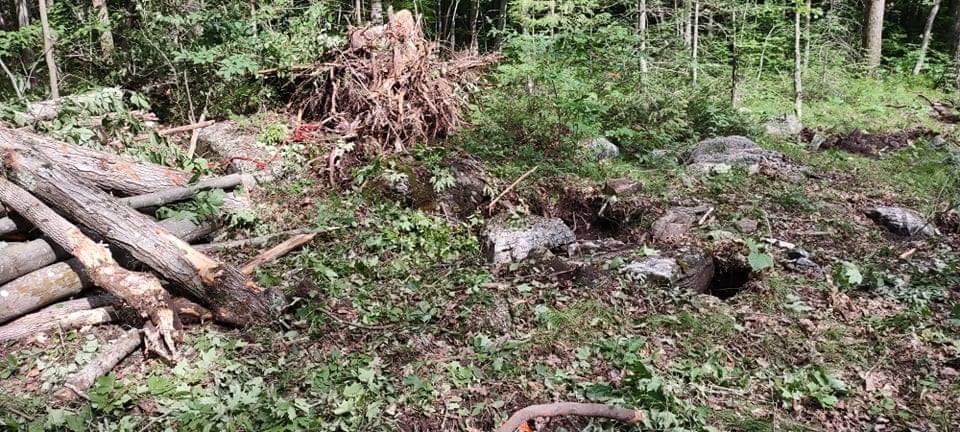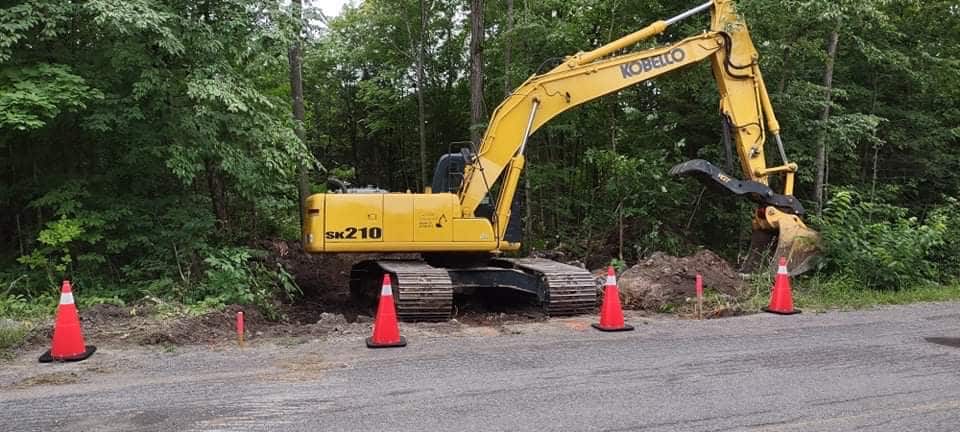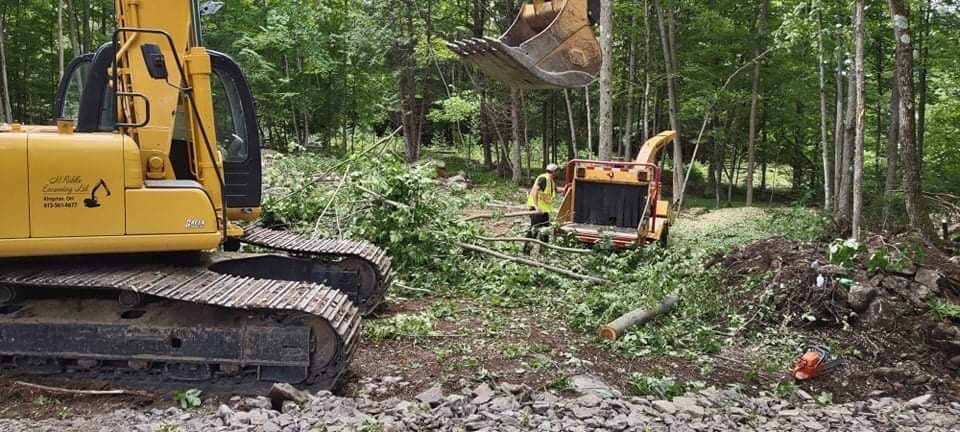Understanding the Permit to Clear Land
Clearing your land in Kingston, Napanee or South Frontenac often triggers questions about the Permit to Clear Land. Understanding when you need it, where to apply, and what to expect can save time, money, and headaches. This homeowner’s checklist walks through the process step by step so you can confidently plan your project with compliance in mind and no unpleasant surprises.
For many properties, especially wooded or overgrown lots, obtaining a Permit to Clear Land may be necessary before any trees, brush, rocks or stumps are removed. Clearing without a permit can lead to enforcement actions under local bylaws or conservation authorities, including stop-work orders, fines, or even orders to restore the disturbed site. Municipal and environmental authorities in eastern Ontario take these regulations seriously, and overlooking the permit process can delay a project indefinitely.

Start with the Location and Type of Work
First, consider the nature of the work and the location. In the City of Kingston, removing or injuring trees often requires a tree permit under the municipal tree regulations. The city’s Tree Bylaw outlines when you must apply, especially if the work affects healthy canopy trees or trees on slopes, near watercourses or in environmentally protected areas. Even if you’re not cutting protected trees, you may still need a Permit to Clear Land to comply with Kingston’s yard cleanliness standards, which regulate debris, overgrowth and site conditions.
Zoning and Planning Considerations
Secondly, zoning and planning approvals can affect your Permit to Clear Land requirements. In South Frontenac Township, any land use changes – including clearing – must align with zoning by‑law 2003‑75 and the Official Plan. It is wise to determine your property’s zoning via Frontenac Maps or through the Township planning department before starting work. Ignoring this step might lead to needing a consent or severance if lot configurations change, which can be costly and time-consuming to address. The County of Frontenac also plays a role in lot development, so coordination with Frontenac County’s building department is often necessary for broader projects.

Your Homeowner’s Checklist: What to Review Before You Clear
To keep things organized, we’ve outlined a checklist to help determine when a Permit to Clear Land is required and what you’ll need to get started.
Check Local Bylaws First
Begin by reviewing local bylaws. In Kingston, the Yards Bylaw and Property Standards Bylaw regulate the presence of refuse, debris, and hazardous vegetation. Landowners sometimes assume they have unrestricted rights on their own property, but in reality, land clearing without approval may be considered a violation even on private lots. A proactive approach to applying for a Permit to Clear Land can help avoid notices of violation or stop-work orders.
Confirm Zoning and Planning Implications
Next, confirm zoning and planning implications. In South Frontenac, the Official Plan and zoning bylaws control the use and appearance of land. Clearing a lot that’s zoned for agriculture or natural heritage protection could trigger additional review. A pre-application meeting with planning staff is often advised before submitting your Permit to Clear Land application, particularly if you are preparing the site for residential construction or future subdivision. Pre-consultation helps avoid delays and ensures your plan aligns with current policy.

Evaluate Additional Permit Needs
You will also need to check if building or site alteration permits are required in addition to your Permit to Clear Land. While the Ontario Building Code does not regulate tree or brush removal directly, it does govern work related to structures, septic systems and grading. If your land clearing involves excavation or slope adjustments in preparation for these projects, you may require further approvals. For instance, if your project involves a new septic installation, you may need to file a separate application with the Frontenac County Building Department. This step-by-step guide to getting a septic permit can help you understand what to expect throughout this process.
Don’t Overlook Environmental Approvals
Environmental approvals are another layer. If your property contains or borders wetlands, floodplains, or lakeshores, you may need permission from a conservation authority such as the Cataraqui Region Conservation Authority, Quinte Conservation or Rideau Valley Conservation. These agencies regulate vegetation removal in sensitive areas and may require environmental assessments before issuing a Permit to Clear Land. If unsure, consult the Township of South Frontenac’s building resources or check with conservation staff directly.
Preparing and Submitting Your Application
Once you’ve confirmed the need for a Permit to Clear Land, assemble your application. Most municipalities require a site plan, tree inventory, erosion control strategy, and an outline of the work. You may also need to show the location of any existing structures, property boundaries and natural features. If your property has steep grades or is close to water, your application may need to demonstrate how runoff and sediment will be managed during and after clearing.
Using the Right Submission Channels
Kingston offers the DASH portal for submitting tree and site alteration applications, which helps coordinate reviews between multiple departments. In South Frontenac, applications go through the Planning or Building departments, depending on scope. You may need to coordinate with engineering staff if clearing affects drainage, culverts or road access.

Work with Professionals Who Understand the Process
Before any work begins, coordinate with M. Riddle Excavating. Our team understands local regulations and has experience navigating permit pathways in Kingston, Napanee and South Frontenac. By combining land clearing expertise with municipal knowledge, we help clients avoid unnecessary delays. Previous projects we’ve completed offer valuable insight into how real land clearing operations unfold and what homeowners can expect when obtaining a Permit to Clear Land in eastern Ontario.
During and After Land Clearing: Stay Compliant
On-site, all permit conditions must be followed. This could include installing protective fencing around trees to remain, using erosion blankets on exposed slopes, or scheduling work to avoid bird nesting seasons. Your Permit to Clear Land may also include restoration requirements, such as replanting native vegetation or stabilizing disturbed soil. After the work is done, a final inspection may be needed to confirm compliance and close out the permit file.
Final Thoughts: Why Permits Matter More Than You Think
In summary, a Permit to Clear Land is generally required if your work impacts vegetation, zoning, site grading or regulated environmental features. The process can involve multiple layers of oversight from municipalities and conservation authorities. Skipping this step risks legal and financial consequences. Taking the time to map out your permit requirements, engage the right professionals, and sequence the work appropriately helps your project proceed safely and legally.
Whether you’re planning a large-scale rural development or simply cleaning up an overgrown lot, M. Riddle Excavating can help ensure that your Permit to Clear Land is secured and that the work is carried out to the highest standards. From the first call to final inspection, our team supports clients across Kingston, Napanee and South Frontenac with trusted site preparation, septic system design and heavy equipment operation.
If you’re unsure where to start, we invite you to explore our full range of services or contact us directly for guidance. Understanding Permit to Clear Land requirements, planning ahead, and working with experienced providers ensures your project proceeds efficiently, legally and with full peace of mind.
